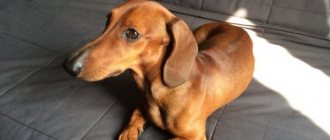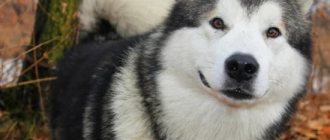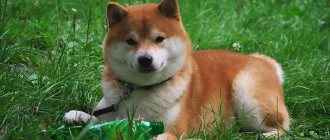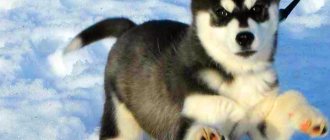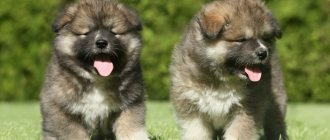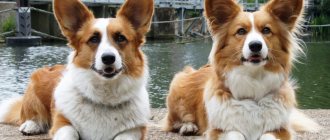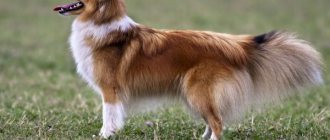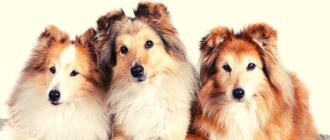Description of the Alaskan Malamute breed
Popularity 190th place among 263 dog breeds
Lifespan:
14-16 years old
Breed group:
Service
Height:
males: 63 cm, females: 58 cm
Country of origin:
USA
Average price:
20-30 thousand rubles
Weight:
males: 36-43 kg, females: 32-38 kg
Latest articles Cat health
Rabies vaccination for cats: choice of vaccine, necessity, schedule 01/22/2022 4 0 0
Selection and adaptation
TOP 20 best cat breeds for families with children 01/22/2022 25 0 0
Basic rules of care
The coat of the White Alaskan Malamute is not prone to matting or getting dirty quickly. Therefore, in normal times it is enough to brush your pet once a week. It should be bathed as needed, but not more than 2-3 times a year.
Eyes, ears and claws usually do not require special care, but they should be carefully examined after every walk and in the morning..
In case of contamination, ears should be cleaned with a cotton swab, eyes should be wiped with a cotton swab or a soft cloth with a special composition applied to them.
Malamutes' nails rarely require grooming, but if they do not wear down, they should be trimmed with a nail clipper for large dogs.
To clean your dog's teeth, you can give your dog chewing cartilage or special treats purchased at a pet pharmacy..
If the pet eats soft food, then its teeth must be cleaned additionally using a toothbrush for dogs and a special toothpaste.
If your white malamute develops tartar, it is recommended to consult a veterinarian..
Key facts
The description of the Alaskan Malamute breed emphasizes that it is a representative of a large breed of dog. The history of the origin of these northern giants is connected with the Malemute tribe, who previously lived on the coast of Alaska. From ancient times to this day, strongly built, muscular dogs easily cope with the work of dog sleds - all thanks to their physical endurance and resistance to harsh conditions. The external similarity of this beautiful dog with a wolf attracts increased attention.
The characteristics of the Alaskan Malamute breed say that the dogs are very smart and willful. The handsome Alaskan is good-natured, energetic and loyal, but by no means weak-willed or submissive. The stubborn nature of the Arctic giant and the desire to control his relatives and people sometimes prevent him from being raised under normal conditions. But when extraordinary situations arise, this character trait of the Alaskan Malamute can save a person.
The main feature of Malamutes remains their predisposition to draft work; without load, such dogs become lazy, spineless and stupid.
These giants are in good health, which is a great advantage of the breed. The lifespan of the Alaskan Malamute is long and easily reaches 15-16 years.
Breed standard
The Alaskan Malamute breed is large. An adult male grows up to 64 cm, and a female – up to 58 cm. The animal weighs from 34 to 38-40 kg. Errors are undesirable. The dog has a very strong physique and a powerful skeleton. The chest is deep.
The body is rectangular, slightly elongated. The loin is weakly expressed, but the withers are clearly visible. There are dense skin folds in the neck area. Wide paw set. The hind thighs are more powerful than the front ones. The stomach is not sunken. The tail is set high and lies in a “ring” on the back.
A wide, large head looks harmonious against the background of a strong body. The muzzle is slightly pointed, extended forward. At the tip there is a large nose. Her cheekbones and cheeks stand out well. The teeth are very sharp, especially the fangs. They have a bright white color.
The ears are in the shape of a triangle, set symmetrically. According to the standard, they cannot be recumbent. Such a defect in an individual is a reason for its culling. The dog's lips should be pressed firmly against the gums. There should be no saliva dripping from his closed mouth.
The Alaskan Malamute in the photo is a smart and very kind dog. This external image is largely deserved by him due to the presence of large slanting eyes. According to the standard, their iris should be brown. If you see an individual with blue eyes, then you know that she is of low breed.
Representatives of the breed have a very hard coat, while the undercoat is soft. This is a natural necessity. Their fur is covered with moist fat, which performs a waterproof function. Most often, the body of Malamutes is covered with silver-white hair (there is a “mask” on the face). It is less common to find an individual with red spots.
History of the origin of the Alaskan Malamute
The Alaskan Dog is the oldest representative of the indigenous dog breeds in North America. As archaeological excavations confirm, the Malamute is one of the first dogs domesticated by humans. Perhaps today's northern giants are descendants of once domesticated wolves.
When looking at these dogs, there really is a resemblance to wolves, which was proven by scientific research conducted in 2004.
The descendants of wolves came to Alaska thanks to their owners, who swam across the Bering Strait about 14 thousand years ago. The main purpose of the Alaskans was to transport heavy cargo in harsh Arctic conditions.
In ancient times, northern giants helped their nomadic owners hunt and also guarded their homes. Life in the far north played a huge role in the development of dogs as a breed. The constant lack of food, harsh living conditions, hopeless cold - all this contributed to the preservation of only those representatives who turned out to be stronger and more resilient than the rest.
At the end of the twentieth century, Alaskan Malamutes won the hearts of Europeans who came to Alaska under the influence of the gold rush. Streams of foreigners wanting to get rich from gold mining kept coming. And every European was interested in acquiring a convenient and reliable means of transportation on the ground.
Alaskans were the only animals that were able to withstand the harsh conditions of the north. They provided assistance in moving cargo and transporting people. The increased demand for these dogs contributed to an increase in their prices. By today's standards in dollars, then they paid for them from 13,000 for one unit and up to 40,000 for one team. Alaskans were in high demand among gold miners, despite the high price.
In an effort to obtain an even more hardy breed, Europeans tried to cross local Malamutes with Newfoundlands and St. Bernards brought specifically for this purpose. The breeders did not get the expected results, because the resulting offspring turned out to be unable to work as a team.
At the beginning of the last century, dog sled racing gained popularity in America. The sport gained historical fame in 1908 with a 408-mile race called the All Alaska Sweepstakes. Dogs from all over Alaska participated, and for the winning owners, this meant receiving monetary rewards and recognition.
But! Malamutes proved unsuitable for racing because they were not as fast as other competing dogs. Because of this, they tried to crossbreed Malamutes with representatives of small breeds. Attempts led to the threat of extinction of Alaskans as a species. In 1920, the number of these dogs reached a critical minimum. Only thanks to a team of enthusiastic breeders, consisting of several people, was it possible to preserve the breed.
The Second World War also caused great damage to the number of purebred dogs. The participation of four-legged helpers in hostilities almost led to the complete disappearance of the breed. In 1947, when there were only 30 Malamutes, through selection it was possible to restore the breed of Arctic beauties.
Today, Alaskans are considered a popular and famous dog breed. Many northerners will be happy to purchase such a pet. Adapted for centuries to hard work, dogs still perform their basic functions despite the fact that they have come to be considered the official symbol of the American state of Alaska.
History of the breed
The history of the breeding of this dog breed is surrounded by mystery, since no mention of the method of their appearance has been found. But the first mention of these dogs is found in the history of a local tribe living in Alaska - the Malamute tribe. It was its representatives who used such dogs for transporting heavy loads, as well as for moving from place to place in the cold northern climate.
Subsequently, these dogs were used by gold miners who flooded this area during the “gold rush” that swept America. Many of these adventurers brought with them their dogs, which they bred with the local Malamutes to produce tougher, stronger specimens. As a result, at the moment there are practically no purebred representatives of this breed.
American sleigh racing enthusiasts with sled dogs often use Malamutes for this purpose. But this breed was officially registered only in 1935. At the same time, the Alaskan Malamute Club was formed, and Milton Seeley became its president.
Appearance of an Alaskan Malamute
General impression
The Alaskan Malamute is a powerful, hardy and friendly dog that looks very much like a wolf. This similarity causes not fear, but admiration. Even the photo of the Alaskan Malamute shows how beautiful and harmoniously built this dog is.
Head
Powerful, wide, deep-set. The head blends very harmoniously with the dog's body.
Neck
Strong, powerful, slightly curved.
Torso
Average, not very massive, but the bones are strong. Strong muscles are not visible under the thick fur - but rest assured, they are there.
Forelegs
The front legs of the Alaskan Malamute are quite well developed, they are distinguished by strong bones and powerful muscles. The paws are straight up to the pasterns, parallel to each other. The shoulder blades are slightly inclined. The pasterns are strong, but not long - deep, adapted for walking in the snow. The pads are well developed. The phalanges of the fingers are tightly pressed, curved. The claws are impressive.
Hind limbs
The hind limbs are no less powerful. Located on the same level as the front ones. The thighs are very muscular, the knees are medium angular. The hock joints are close to the ground, almost invisible. The toes and pads are the same as on the front feet.
Tail
Raised above the back, without touching it or twisting. Densely covered with fur.
Movements
Confident, smooth, but massive. Its impressive size does not prevent the Malamute from remaining agile. Strong hind limbs have the ability to transfer movement using the lower back to the forelimbs. The forelegs soften the powerful pushing force of the hind legs in a smooth and wide step. The front and hind legs move at a moderate distance from each other.
Wool
The Alaskan dog has a double coat.
The first layer of wool is hard to the touch, it performs a protective function. The second undercoat is soft but dense - it warms the animal. The length of hair varies on different parts of the body. For example, the neck, shoulders, rump, hips, tail and down the back have longer hair than the rest of the body. The Alaskan's coat becomes shorter and thinner in the summer, even if it is not clipped.
Color
Most of all, Malamutes are characterized by wolf coloration.
But they can also be black, gray, white. There is a sable color of the Alaskan Malamute. White hair is most often located on the lower part of the body, in rare places on the paws or as a mask on the face. There is a stripe on the forehead, a spot or a collar in the back of the neck.
Size
The Northern Beauty is a fairly large dog.
The weight of the Alaskan Malamute can reach up to 50 kg, and the height at the withers of some dogs is higher than 60 cm. On average, males of this breed weigh between 38-43 kg with a height of up to 63.5 cm, females – 34-38 kg with a height of up to 58 .5 cm. The height of the Alaskan Malamute is determined by the standard, but may exceed it if the individual is not a show animal.
The size of the Alaskan Malamute means that it will be kept in an aviary rather than in a cramped apartment.
Advantages and disadvantages of Malamutes
The advantages of these dogs include:
- friendliness;
- powerful muscular body and limbs;
- appearance;
- endurance;
- high activity.
But representatives of this breed also have disadvantages that you should know about in advance:
- have a stubborn character, and representatives of the breed are prone to aggression, so raising puppies should begin from the first day;
- and Kotzebue Malamutes, on the contrary, are too trusting even towards strangers, so representatives of this subtype cannot be used as watchmen;
- these individuals are undoubted leaders prone to dominance;
- Malamutes are overly independent.
Character of the Alaskan Malamute
The Alaskan Malamute is a dog that perceives everyone around him with his inherent friendliness. These northern beauties are very energetic and active from early childhood - only by the age of three they become a little calmer. These dogs require increased attention: you need to constantly play and run with them.
Outwardly similar to a wolf, the Alaskan is not at all adapted to hunting or protection. So leaving it in the house in the hope that it will protect property from thieves is frivolous. Rather, he will kindly and joyfully greet the insidious burglar, mistaking him for a friend. Alaskans cannot bark, but they sing excellently.
Malamute strives to dominate everywhere. And if you raise him incorrectly, then he is unlikely to be good-natured and sociable. The pet has an excellent memory. This fact is important to consider when raising children. He can remember any rudeness committed during training later, and then even take revenge for it.
It’s difficult to call this pet a monogamous person: if you offend him and lose his respect, he can immediately switch his interests to another person. The Malamute is used to living in a pack, so it is important for him to be surrounded by people or dogs. At the same time, the northern giant cannot be kept in a confined space or left alone for a long time.
It is not advisable to leave a dog with small children, because in its desire to control everyone, it may inadvertently harm the child. Good-natured towards people and dogs, Malamutes often show aggression towards other animals and birds. In order for the handsome Alaskan to accept the company of other pets, he needs to be introduced to them as early as possible.
Most likely, the Alaskan will dominate among the other favorites. This Arctic dog has a strong character and a great desire to be above everyone else.
Malamute cost
The price primarily depends on what characteristics the puppy has:
- Show-class puppies with prospects for participation in exhibitions and shows. These are the best representatives, and their cost can reach 150-180 thousand rubles . Often such puppies are left in nurseries to maintain the purity of the breed and win medals. After all, a dog from famous parents can be sold profitably.
- Breeding class - ideal for breeding a breed, assessed by good heredity and reproductive ability. Of course, females in this category are valued higher than males. The price for a puppy varies from 60 to 140 thousand rubles , depending on the pedigree.
- PET class - dogs that are not of interest in breeding, or have defects in appearance. This does not in any way affect the character and health of the pet, but such puppies are the most inexpensive - from 10,000 to 80,000 rubles .
The price is determined based on the external characteristics and temperament of the puppy. The price range is wide, so all nurseries recommend deciding in advance the purpose for which you are getting a dog. It is also worth paying attention to the Malamute’s parents - the presence of titled parents guarantees that it meets the breed standards.
Another fact is that a Show class puppy who has reached the age of 6-8 months will cost more than a PET class puppy of the same age, due to the fact that it is easier for a teenager to assess whether he will be successful at shows and competitions, and whether there are any defects in the exterior and body structure.
Education and training
Malamutes are very active and intelligent. From birth they are determined to lead. Therefore, when raising and training an Alaskan Malamute, it is important to be firm and confident. You need to let the dog know that it has an owner and he is the boss here, not the animal. But the pet will not tolerate aggression or attacks, so the best option is not to scold for mistakes, but to reward for correctly executed commands. It will be optimal to conduct training in a playful way.
The load during education should be increased gradually. You can train your puppy from a very early age. It is important to instill in him:
- hygiene skills;
- the habit of responding to a nickname;
- ability to execute simple commands.
You can go to training grounds from the age of 4 months, after the end of quarantine for vaccinations. If your pet lives in a big city, then you need to teach him to be calm about extraneous sounds, passing cars, and other sources of sudden noise.
Your pet will easily master long running distances, but only if it is not a test of speed - Malamutes are more resilient than fast. In these types of competitions, Alaskan beauties are inferior to other dog breeds, but if you need to drag a heavy load over long distances, then there is hardly a stronger opponent.
When training, the Malamute's stubbornness creates significant interference. But thanks to their exceptional mind and high intelligence, they can immediately remember and carry out any commands. Alaskans perform tasks no more than 2-3 times, because they do not like to repeat the same actions over and over again. Arctic dogs will quickly lose interest in the entire training process if this fact is not taken into account.
Looking for an Alaskan Malamute? Find your pet from 2 offers As a gift
Description and features
It is believed that the first owners of the Alaskan Malamute dog were Eskimos. A long study of this issue led to a precise definition of the tribes that tamed the animals - the Malmuts. They lived many centuries ago in Alaska.
Outwardly, the dog gives the impression of being powerful, resilient and even dangerous. Yes, he is strong and majestic, but he is not at all aggressive, and therefore does not pose a threat. Thanks to its thick fur and undercoat, it does not freeze at all, even in extreme cold.
Interesting fact! Representatives of this breed actually descended from wolves. People probably crossed forest predators with large huskies. But, Malamutes are absolutely tame, not prone to aggression, like their closest relatives.
The physical parameters of these dogs are excellent. They can carry heavy loads even over very long distances. That is why they have always been exploited by the inhabitants of the Arctic as riders. They are genetically adapted to heavy physical labor.
But it is not advisable to have such a dog solely as a working dog. She is a good and faithful companion who will never leave her beloved owner, but will take care of him as long as he needs consolation. He loves active recreation, especially sports games, such as frisbee.
If you want to have such a pet, you must understand that a quiet lifestyle is not for him. He prefers to move most of the day rather than sleep or rest. Loves long walks, running, jumping, etc.
Constantly being at home makes such a dog unhappy. He enjoys being outdoors and interacting with his fellow creatures. Malamute is a pack dog, so it clearly understands that in any social system there is a hierarchy. This makes it easy to operate. The dog is well trained, as it tends to trust and respect people.
Very kind and welcoming. It extremely rarely barks at strangers who come into the house. Strives to please everyone. For him, guests are potential toys with whom he can have fun. None of them will bite or offend.
Malamute is a very friendly and strong dog
As a bodyguard and watchman, he is not effective. Observation and caution are character qualities that are absolutely not characteristic of huskies. But they have other advantages - mercy, responsiveness, friendliness, playfulness, good motivation to learn, etc.
Health and Diseases of the Alaskan Malamute
Possible diseases
Alaskan Malamutes are very hardy.
They easily tolerate harsh climate conditions. But they are still susceptible to some diseases. They may exhibit neurological disorders affecting the peripheral nervous system – polyneuropathy. They are susceptible to diseases such as hip dysplasia, anal adenocarcinoma (malignant tumor), diabetes, and hemophilia. They are also prone to dermatological diseases such as atopic dermatitis and demodicosis. Less common eye diseases are: progressive retinal atrophy, cataracts, hemeralopia (day blindness), glaucoma.
To improve the health of an Alaskan, it is important to vaccinate him every year. Once a quarter it is necessary to do prophylaxis against worms, at least once every two weeks to clean the pet’s ears, brush the fur and teeth. In the warm season, you need to give a special anti-tick remedy.
Compared to other breeds, Alaskans are long-lived. Many of them live up to 16 years.
Reproductive health
Malamute bitches begin to come into heat around the age of one year.
If the first estrus was noted before 7 months of age, you need to contact a veterinarian, this may be bleeding. There is no need to rush into mating: a female can become pregnant normally only on her third estrus, that is, about 20 months. Males are bred no earlier than they reach two years of age.
Before going into heat, a dog can behave strangely: its character deteriorates, it becomes overly stubborn and restless. In addition, estrus occurs once every six months and lasts 20 days: in this case, the discharge from the loop is very abundant. This can be a problem for some owners, so unless you plan to breed, it is best to have your female Malamute spayed.
Kinds
Breeders standardized 2 types of breed - Kotzebue and M-lut. Each of them has a number of distinctive features. For example, the first one is less powerful and hardy. But such dogs are much kinder, and they also have well-developed sociable abilities. If we talk about m-loot, it is worth noting that this dog is capable of aggression. It is larger, has amazing endurance and strength.
Modern breeders often argue as to which of these types of Malamute is more correct. Most families prefer the Kotzebue, considering it a good, big guy. But there are husky lovers who need to protect their territory. M-loot is more suitable for them.
Features of feeding and diet
The Malamute is a rather large dog, but this does not mean that it needs to be fed a lot. On the contrary, it is necessary to develop clear feeding frameworks from puppyhood on a specific time and portion. Because a Malamute can eat any amount of food every time it is offered, even if it is full. Adult dogs should be fed no more than twice a day, while puppies should be given food three times a day at a strictly timed rate.
When choosing a diet, you need to take into account the norms, which for puppies are 140 Kcal per 1 kg of body weight, and for adult dogs - 75 Kcal/kg. For an elderly Malamute, it is better to stick to a diet that does not exceed 35 kcal per 1 kg of his body weight.
To feed puppies you can use: cottage cheese, boiled eggs (once a week), vegetables and fruits, raw or boiled meat, milk porridge, sea fish - boiled and boneless. Water should always be in an easily accessible place.
Adult Malamutes can be fed premium dry food. Such feed contains a sufficient amount of vitamins and microelements. In another case, a mixture of cereals is prepared for four-legged animals in broth with the addition of pieces of beef tripe or trimmings.
You can also feed your pets boiled meat, crackers and biscuits. It is advisable to do this infrequently and as a reward - for example, for a completed command.
Character
The kindness of Malamutes is limitless. These dogs love people very much, they quickly become attached to them, finding an approach to everyone. The idea that likes are capricious is wrong. They are loyal, friendly and responsible, so they make good contact with any person.
A representative of the breed expects similar qualities from people. He likes to be the center of attention, but not when alone. He prefers to surround himself with noisy people who are not averse to playing and having fun.
He likes active rather than passive recreation. When going outdoors together, be prepared for the fact that your pet will not leave you alone. He will start rushing around people, jumping, making loud noises, calling them to play.
Representatives of the breed get along especially well with children. They are naturally responsible, so they can serve as house nannies. They will never leave the baby alone if there are no adults nearby. They carefully watch him so that he doesn’t get into trouble.
They can enter into a fight with a stronger opponent who threatens the peace of their family. From its closest ancestor, the wolf, the Alaskan Malamute inherited courage, courage and fearlessness.
Malamute dogs are very active and need long walks every day.
You can definitely rely on such a dog. Leaders by nature. Moderately proud and stubborn. They prefer to play rather than study, however, they are quite savvy and, with the right approach, well managed.
Interesting! The Alaskan Malamute never barks, but not because he has a calm disposition, he simply does not know how to do it. The sound the dog makes is more like a snort or purr.
It is very important to systematically demonstrate your love to such a dog. She needs a strong emotional connection with her owner. Requires attention and care. A Malamute that does not receive love becomes unhappy and inactive.
How to communicate with him correctly so as not to offend? Express admiration for your pet, pet it, talk quietly and gently in its presence. This way he will understand that he occupies an important place in your life.
Tends to choose one owner and carries out only his commands. This is considered a disadvantage of a pet, as other household members may have difficulties raising it. Can learn to fetch slippers, carry bags and even play hide and seek.
Most huskies, including the Alaskan Malamute, are very stubborn. They are happy to serve a person, but only if their mood is high. They often refuse to follow commands when they are puzzled or sad about something.
Care and maintenance
The Alaskan Malamute has a thick coat, so it can live outdoors all year round. The main thing in the care and maintenance of the Alaskan Malamute is constant coat care. It needs to be brushed, especially when the dog sheds.
It is important for Alaskans to do a lot of physical activity, because it exercises not only the muscles of the body, but also the mind. Without exercise, Malamutes become lazy and disobedient animals.
A country house would be an ideal place to keep them, since the apartment is cramped and hot for giant malamutes. And in a house with a plot, the dog will feel much happier.
You should take into account the Malamute’s love of freedom and provide the pet with free movement from home to the yard and back. You also need to fence your territory with a high fence so that the Malamute does not run outside the fence. Provided that the dog lives outdoors, an excellent solution would be to make a spacious enclosure and place a warm booth there.
It should be remembered that Malamutes are excellent diggers! Even if your home is on a separate property, it is best to train your dog to dig only in a designated area, such as a sandbox in the backyard. Their ancient instinct, which once helped them find at least some food, has today degenerated into the process of obtaining pleasure. Many dog breeders can easily recognize the yard in which the Malamute lives by the pits dug in it.
Features and external data of the breed
If we study in detail the description of the Alaskan Malamute, we will see that it is a large, strong and beautiful dog, which has an extraordinary resemblance to a wolf. In addition to its spectacular appearance, the dog stands out for its irrepressible energy, which not all owners can cope with. Despite the fact that dogs are good-natured towards people, they prefer to dominate them.
If in everyday life the independent character of the Alaskan Malamute is not very pleasing to the owners, then in extreme situations this feature is a big plus. Dogs are able to make their own decisions and save their lives and the lives of their owners in dangerous situations.
In Russia, for a long time, Malamutes were something exotic. However, now the breed has a large number of fans. True, often this admiration for a dog begins to fade as it grows up, because if it is raised incorrectly, it becomes uncontrollable.
This is not the animal's fault. It is the people themselves who are to blame for buying a handsome fluffy dog, hoping that he will grow up obedient and flexible. Without proper education, training and care, it will not be possible to raise a worthy family member. Therefore, if a person is not going to devote a large amount of time to the dog and does not consider it necessary to take into account the dog’s character traits, he should refuse to buy a Malamute.
However, if the future owner of a pet wolf begins to take care of the puppy from the first days, trains it according to the advice of dog handlers, cares for it and devotes the necessary amount of time, then he will not only raise an excellent dog, but also a true faithful friend who understands him at a glance.
Appearance and features inherent in Malamutes
The Alaskan Malamute has a strong build, a muscular body and a dense, thick coat. Representatives of the breed are distinguished by a large head and deep chest, so even female Malamutes have a rather impressive appearance. But looking at the puppies that look like cute teddy bears, it’s hard to believe that in the future they will turn into huge, energetic dogs.
Although dogs have a large skull, it is not heavy. The muzzle is large compared to the black box. The stop is not sharp, but quite noticeable. Dogs have wide jaws with large teeth. A correct bite should be a scissor bite.
Malamutes have almond-shaped, medium-sized, brown eyes. If the iris is blue, then this is considered a disqualifying defect. Dogs have medium, triangular ears. The nose is large with wide nostrils and a black nose.
The neck is powerful and strong. The body is massive with strong bones. The tail is straight, fluffy, raised above the back. The forelimbs have developed muscles and are massive. The paw pads are large, collected, developed with tightly closed toes and protective hair between them. The hind legs are also strong and massive. They are located in line with the front ones.
Malamutes have a double coat. The first type of coat is guard and hard, and the second is soft and dense. In winter, dogs have long hair, and in summer it is shorter and not as thick.
The colors of Alaskan Malamutes are few. The most common is the wolf one. Also, representatives of the breed can be black, gray, white and sable. Colors can be combined. But this is only permissible in the undercoat and underpants area. Color combinations elsewhere are not permitted. The white color is more in the lower part of the body, on the paws and face in the form of a mask. A white spot on the forehead and a stripe on the back of the neck are allowed.
"Important! The color of Alaskan Malamutes is called mantle, this eliminates the presence of both uneven color and spots that break it.”
Possible disadvantages
Any deficiencies and pathologies of a dog’s limbs are considered serious defects. In Malamutes they are represented by a cow-like set of hind legs, their spacing, weak pasterns, straight shoulder girdle or insufficient angles.
Also defects are stilted or other types of movements, incorrect proportions, too powerful or, conversely, a slender physique.
Disqualifying faults
These include blue irises or other obvious physical abnormalities. Mental symptoms include cowardice or increased aggression. Also a defect will be cryptorchidism detected in a male dog.
Tips for choosing a puppy
It is best to purchase Malamute puppies from registered kennels or from private breeders who will provide documents confirming their purebredness and the absence of any defects. Such certificates are officially certified by the Russian Cynological Federation (RKF) and the Union of Cynological Organizations of Russia (SCOR).
In order for the purchased puppy to quickly wean itself from its pack and become attached to its new owner, it is advisable to adopt it at the age of 1 to 4 months. But if the dog’s exterior characteristics are more important, then it is better to wait until an older age, when it will be easier to predict the size of the Malamute.
Healthy babies have dark eyes, a lively look, straight and plump paws, a small belly, and a thick tail. The puppy's color is the same as that of an adult dog. The coat is thick and fluffy. There is a good test for the presence of leadership qualities in a puppy: if you put a collar on the puppy and, slowly walking away, pull on the leash, then the future leader will boldly and confidently follow his new owner.
Marriage or breed?
The white color of Malamutes is considered standard and is not a defect in the breed.
Expert opinion
Kozhevin Semyon Kirillovich
Expert dog handler.
“The White Malamute is a dog of compact build, distinguished by snow-white thick, fluffy, two-layer, not too long hair. At the same time, the hair coat of Malamutes in the summer is shorter than in winter and less dense. By nature, these are friendly and active dogs, which, despite their impressive appearance, are too good-natured to become reliable watchdogs. White Malamutes are quite silent, they are one of those few dogs that hardly bark, but are capable of making grumbling sounds of various tones, so that from the outside it may even seem that the pet is talking to its owner in this way.”
How to choose?
First you need to decide on the gender of the puppy.
Males are stronger and more robust, they look more impressive and are more suitable for an exhibition or sports career.
Bitches, having a calmer and gentler disposition, are preferable as a pet, especially if there are children in the house.
Next, you need to move on to finding a suitable breeder or nursery . And, of course, you should not purchase a white Malamute without documents, since only the metric is confirmation of the purebred origin of the puppy.
When going for a future pet, you definitely need to talk to the breeder and look not only at the puppies themselves, but also at their parents. If there is something alarming about the appearance or behavior of adult dogs, then it is better to refuse to buy a baby from this kennel.
The puppy itself should look healthy and active, it should have thick and well-groomed fur, clean ears and skin and shiny dark eyes..
The baby should be playful and friendly towards people, as well as towards the dogs living in the kennel.
IMPORTANT!
Together with the puppy, the owner must give the buyer a birth certificate and an international veterinary passport, and also advise the new owner on what to feed and how to properly care for the pet.

